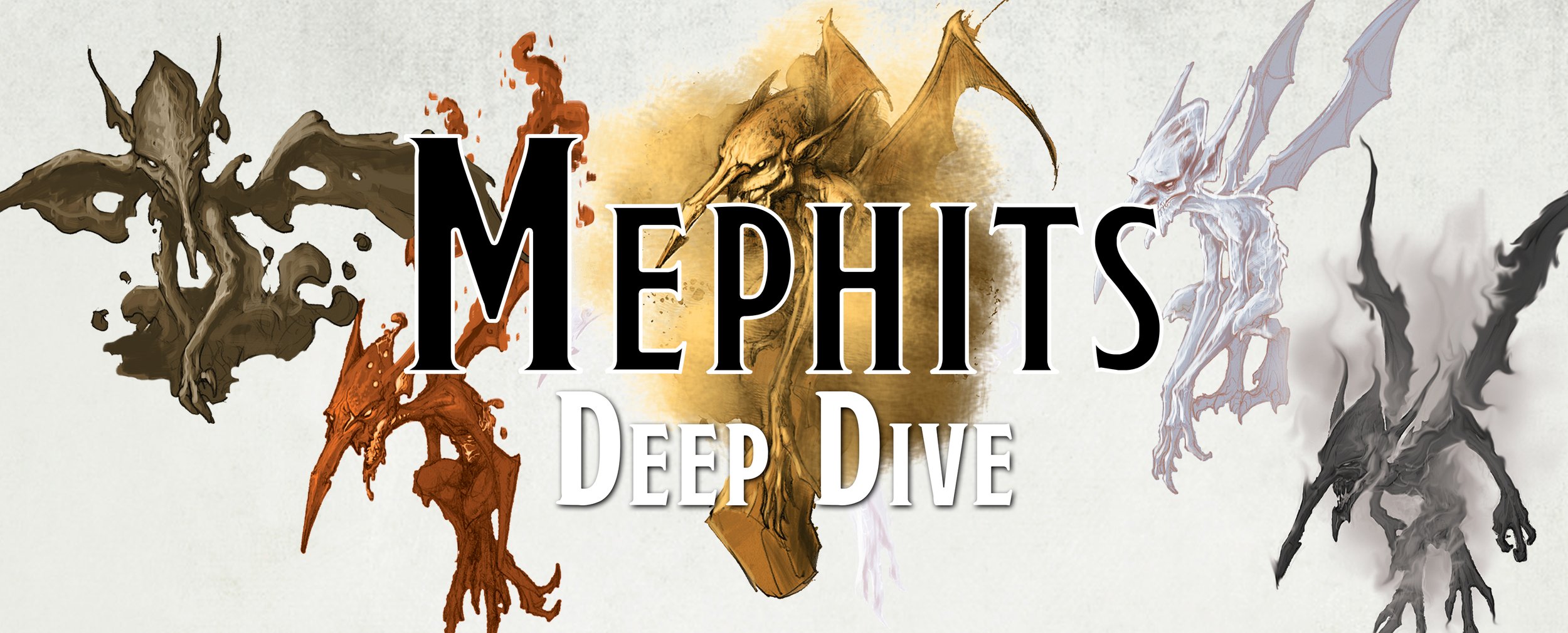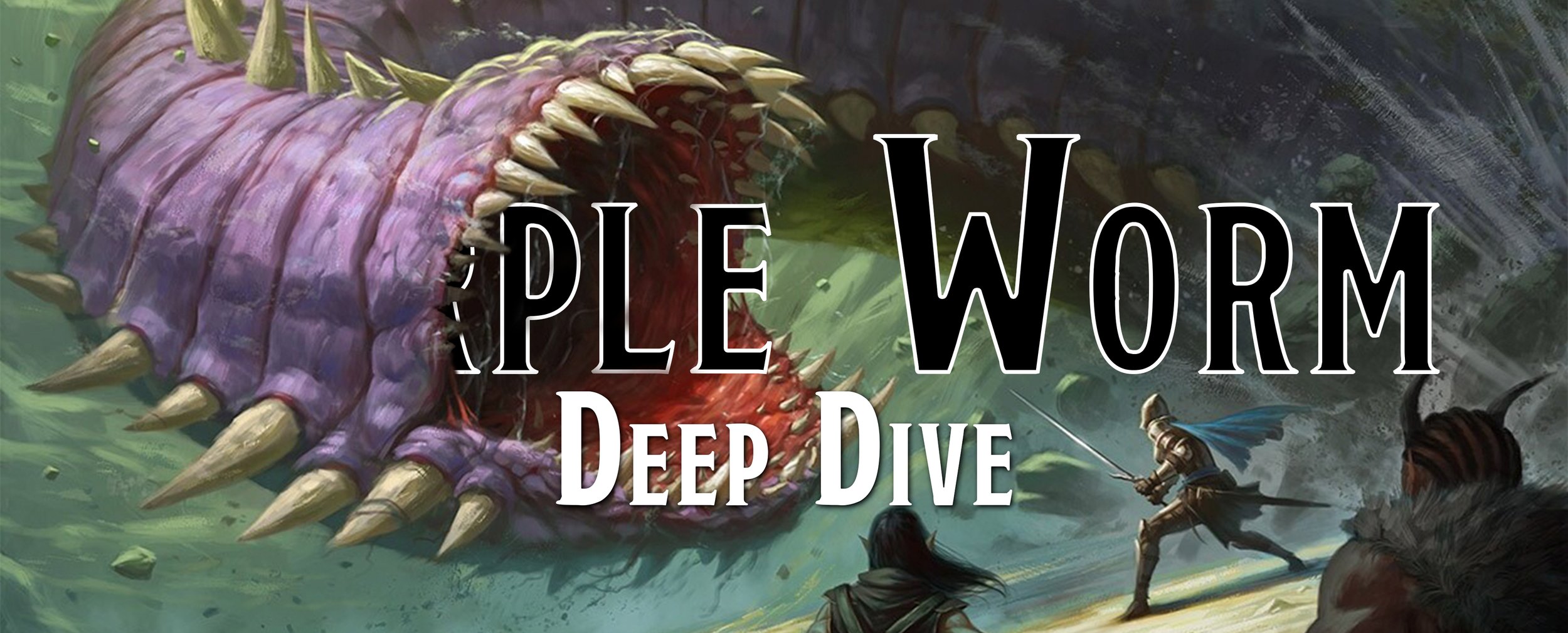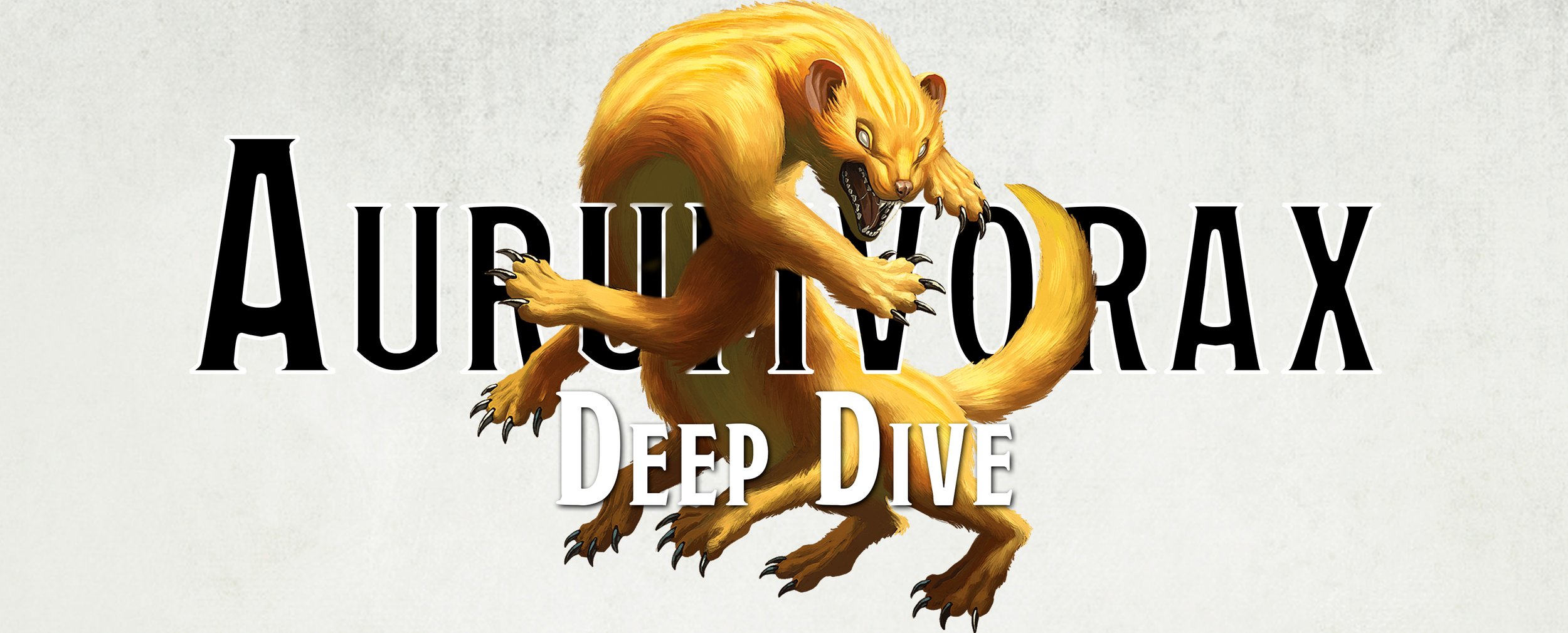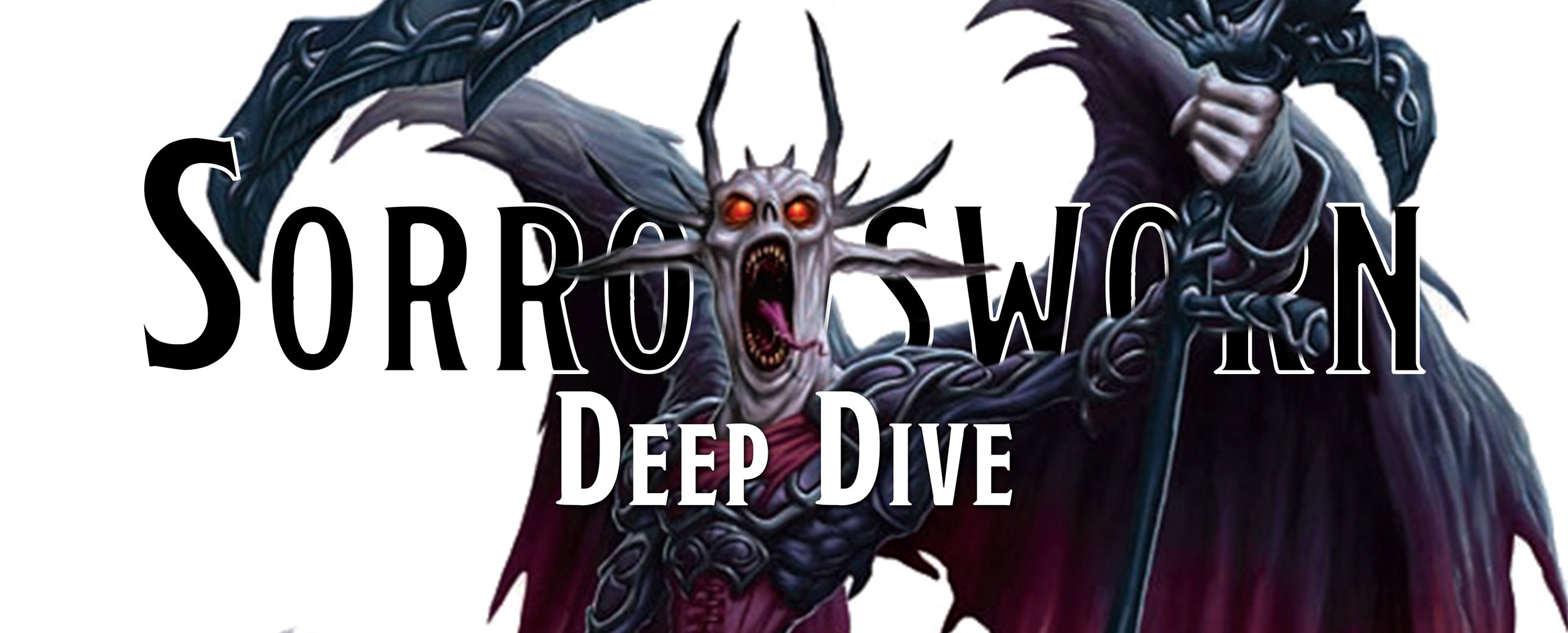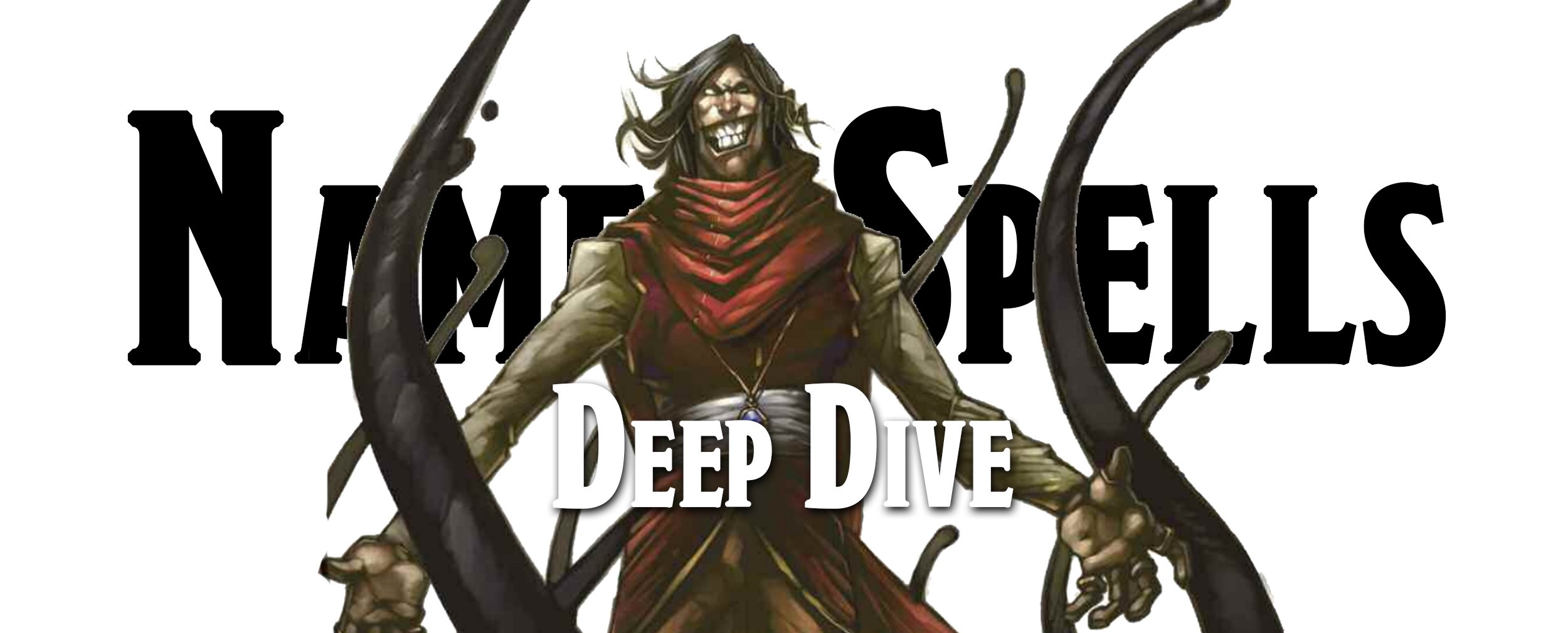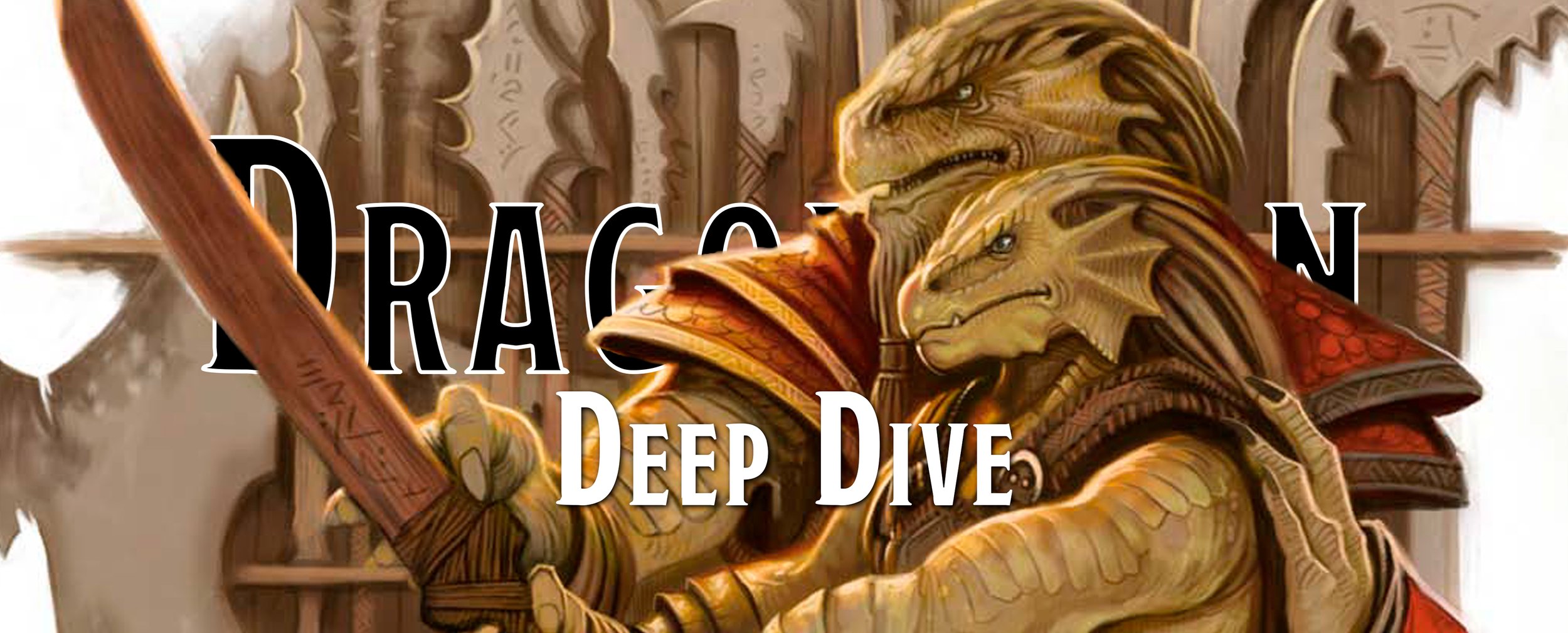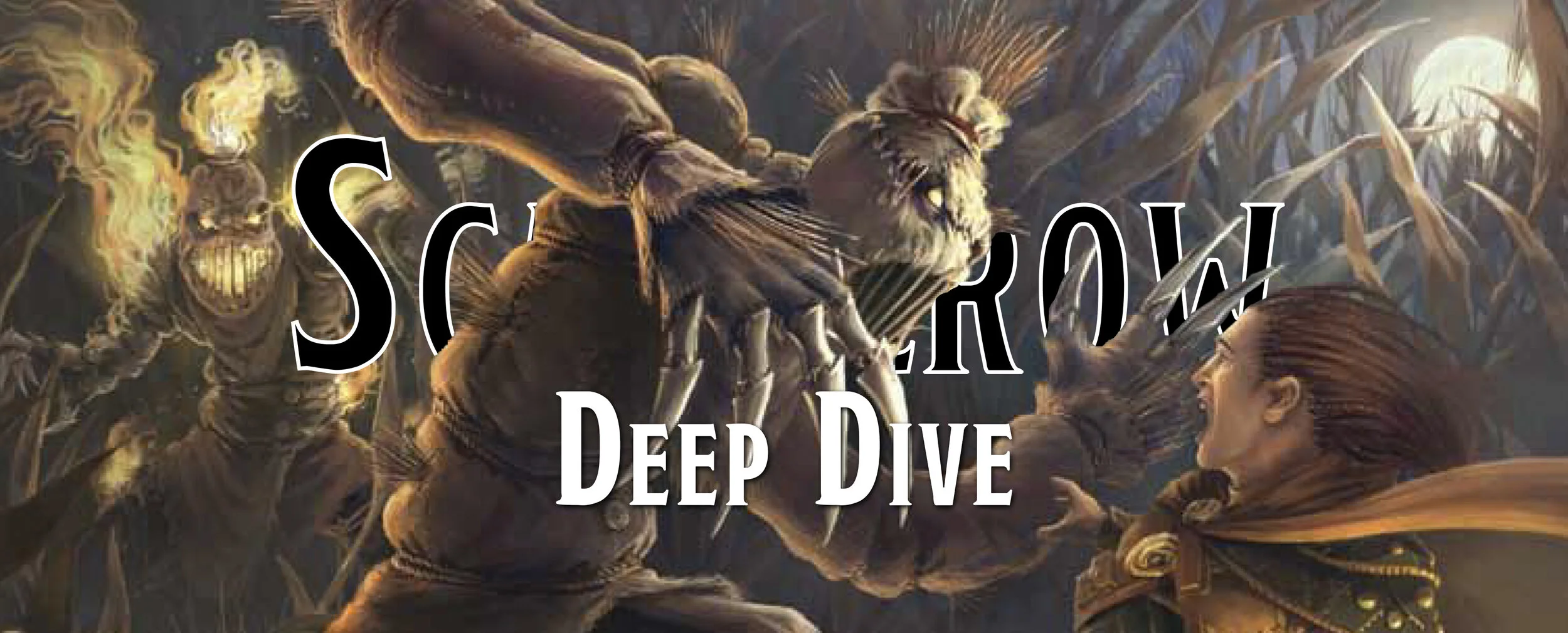Deep Dive - The Named Spells
Have you ever gone through the wizard spell list, found a few names in there and wondered what made them so special, and narcissistic, that they get to name a spell after themselves? The most well known of these spellcasters go by the name of Bigby or Mordenkainen, but what about those smaller ones?
We’ve been seeing a lot of people talking about Tasha and her hideous laughter, but what about Aganazzar’s scorcher? Have you dropped a beat and forced your enemies into an irresistible dance by Otto? Or maybe you wondered who, across the very planes themselves, is using a 6th-level spell to draw invisible sigils with sapphires and casting Drawmij’s instant summons?
We are going to look at a few of these lesser-known spellcasters, how they influenced the game, and look at a bit of history of their biggest spells that made it to 5th edition.
Aganazzar
History of the Wizard
Best known for his spell, Aganazzar’s scorcher, there isn’t a huge amount of information on this individual - which isn’t too surprising. Even for the well-known figures of Bigby or Mordenkainen, you quickly run out of resources unless you are willing to read hundreds of novels in search of tiny asides. Luckily for us, what is known about Aganazzar did not require us to read hundreds of novels.
In a Dragon Talk episode, Lore You Should Know - Obscure Wizards of the Realm (September 2018) Chris Perkins reveals the only reason that he can figure that the one spell named for Aganazzar has survived across the editions is that the name is fantastic. We can't argue with that. The problem is, there is precious little information on the wizard and what is known is quite limited and relies on unofficial sources… even if the person revealing the information is official… sort of.
Let’s first talk about what we know officially, then we can go over our other resources. Aganazzar makes his first introduction in Dragon #92 (December 1984) in the article Pages from the Mages III written by Ed Greenwood from the perspective of Elminster. Aganazzar and the mages Illykur, Presper, and Grimwald established The School of Wizardry in Neverwinter, located in the Forgotten Realms setting, and formed the Covenant, an alliance to help protect the area around them. At the school, he was a teacher and mentored a generation of aspiring wizards, spending as much time as he could nurturing their young minds to expand the power of the Covenant, though that would ultimately fail. His passion was teaching these young apprentices about the Weave, the source of magic throughout the world of Abeir-Toril.
Dragon #92, 1984 TSR Inc.
The Covenant, the organization who wished to foster peace in the northern lands of Faerun, created a book known as The Tome of the Covenant that contained four spells all contributed by the four original members; Aganazzar, Illykur, Presper, and Grimwald. Grimwald’s Greymantle, Agannazar’s Scorcher, Illykur’s Mantle, and Presper’s Moonbow are those four spells, and it was only Aganazzar’s that would survive on to 5th edition and become cemented in the lexicon of Dungeons & Dragons. The other spells are focused on warding themselves from spell effects, shooting orbs of moonlight at your enemies, as well as stopping your enemies from being able to regenerate health, like from a troll’s regeneration or a cure wounds spell.
Looking back at Aganazzar, there isn’t much else to say about him until his untimely death. The Covenant learned of an inevitable war with the orcs that resided in the northern lands that they oversaw. When the Covenant took this information to the rulers, their reputation took a huge blow when their warnings turned out to be from false information and an attack never materialized. It turned out that the Red Wizards of Thay were behind this debacle, which came to be known as the Orcgates Affair. The Red Wizards later launched an attack on the School of Wizardry, and it was during this battle that poor Aganazzar was slain.
But this brings us to the unofficial, but kind of official source of information. Ed Greenwood, on twitter, was asked about additional lore on Aganazzar, and he responded with a few more tidbits, though we can’t be sure if he came up with this on the fly or dug out some old notes, he never got around to publishing, but here it is. Aganazzar was a grouchy mercenary wizard who fought along the Savage Coast North. He had to move around a lot since he was constantly butting heads with his employers and was labeled “incompetent” and a “trickster”. Eventually, he settles down in Neverwinter and when the wizards of Thay attacked him in his rambling mansion, he killed 11 of their members before he perished. The most interesting part of this bit of lore is that his rambling mansion was “three houses cobbled together, a warren of rooms and passages festooned with traps” (Ed Greenwood - Twitter, August 2018), seems like Aganazzar was a fan of the Home Alone movies.
So that’s the history of Aganazzar, a few rare tidbits from the early editions of Dragon Magazine and culminating in a bit of lore from Twitter.
History of Aganazzar’s Scorcher
So what about the spell itself? The basics behind the spell haven't changed much over the editions; a straight-line burst of flame shoots out of your hand and scorches everything in its path. But it starts out as something completely different…
1st Edition - Dragon Magazine #92 (December 1984)
With this spell, a magic-user calls into existence a jet of flame which bursts from his fingertips toward a specific creature. If the target creature is within 7” of the caster, it suffers 3-18 (3d6) points of damage, with no saving throw (assuming it is not immune to the effects of heat and flame). The flame-jet assumes the form of a 2-foot diameter cylinder of fire, up to 7” long, with the caster at one end and the target at the other. This jet remains in existence for 2 rounds following casting, moving as the target or caster move, shifting so as to always point at the target, even if the target creature remains, or passes beyond, 7” distant from the caster. Any creatures touched by the jet as it leaps toward the target or moves sideways following a moving target will suffer 2-16 (2d8) points of damage (save vs. spells for half damage). The touch of the scorcher will set alight all readily flammable materials (such as parchment and dry clothing). It may well even damage sturdier objects.
First introduced in Dragon #92, this spell was created as part of a five-part series of articles known as Pages from the Mages that spanned from Dragon #62 (June 1982) to Dragon #100 (August 1985). It first starts as a chain of fire that connects the caster with a target, it then moves with both, always tying them together, no matter how far apart they might get from one another. This creates a rather humorous image of a wizard casting the spell and then running around the battlefield with a magical chain of fire sweeping across and burning every creature it passes through.
It requires a bit of set up to get this spell going, but the result is basically creating a tripwire to torch all of your enemies with, though it works both ways. Your target could just as easily light up your allies by running about the battlefield with your beautiful chain of fire… maybe you could target your allies, with their permission of course, and then you guys just run around with a chain of fire incinerating your enemies!
2nd Edition - Pages from the Mages (1995)
Upon casting this spell, a jet of flame appears at the caster’s fingertips and bursts out toward one creature or object of the caster’s choice. That target will be hit by this flame for 3-18 points of damage in the first round and 3-18 points the following round, if it remains within the spell’s range. The target has no saving throw against this spell, though anti-fire capabilities such as fire resistance will apply and may reduce or eliminate the damage. Other creatures in the path of the flame jet can make a saving throw vs. spell to avoid 2-16 points of fire damage. A successful saving throw reduces this to 1-8 points of damage. The caster cannot perform other actions the during the second round of the spell or discontinue the spell until it has run its course. If the target moves more than 20 yards away from the caster or takes shelter behind some large, fireproof object in the second round, the flame jet will remain directed toward its original target, even though no further damage can be caused. Like the burning hands spell, this spell will ignite readily flammable material in its path.
Pages from the Mages, 1995 TSR Inc.
First found in the Pages from the Mages, a supplement that consolidated all of the articles of that name in Dragon Magazines past, and later reprinted in the 1996 Wizard's Spell Compendium Volume One. This spell is almost an exact copy of the spell from 1st edition, though there are some new caveats and a bit more explanation for this spell. You can’t end this spell early, which means that your enemy can easily use this fire chain against your allies and you just have to suck it up, and they can avoid taking damage from your fire spell so long as they find a fireproof object to hide behind for the duration or run a huge distance away. The chain is still ‘connected’ to them, but it can’t burn through the fireproof object and the fire only stretches for a limited distance. Still, a pretty cool spell that allows you to interact with the battlefield in a strange and humorous way.
3rd Edition - Forgotten Realms Campaign Setting (2001)
A jet of roaring flame bursts from your outstretched hand, scorching any creature in a 5-foot-wide path to the edge of the spell’s range. Aganazzar’s scorcher deals 1d8 points of damage per two caster levels, to a maximum of 5d8 points of damage.
We don’t want to say the spell is nerfed, but it is definitely a lot less fun now. Sure, it means the spell can’t be used against your teammates as it only lasts for 1 round, but now you can’t play jump rope with your allies and enemies. It was once a team-building activity, and now it is just a tiny dragon’s breath line of fire. Luckily, it can get quite big! At 3rd level when you first get the spell, it starts at 30 feet, but for every 2 spellcaster levels, you can increase that range by 5 feet to a maximum of 55 feet! Your damage also increases as you get more power to a maximum of 5d8, so while it isn’t going to end the world, it’s a good back up spell when you are fighting down a long corridor and need to burn some baddies down.
4th edition - Neverwinter Campaign Setting (2011)
The only mention of Aganazzar in this edition is that the Red Wizards of Thay slew him and started a titanic wizard war that lasted for over 20 years between Thay and the wizards who followed the Covenant.
5th edition - Elemental Evil Player’s Companion (2015)
A line of roaring flame 30 feet long and 5 feet wide emanates from you in a direction you choose. Each creature in the line must make a Dexterity saving throw. A creature takes 3d8 fire damage on a failed save, or half as much damage on a successful one.
At Higher Levels. When you cast this spell using a spell slot of 3rd level or higher, the damage increases by 1d8 for each slot level above 2nd.
First found in the Elemental Evil Player’s Companion (2015), it was later reprinted in Xanathar’s Guide to Everything (2017). Beyond adjusting the damage of the spell, as well as limiting the range of it, the spell is just a copy from 3rd edition. While some of our favorite spells can be found in the Elemental Evil Player’s Companion, this doesn’t really make our list. It’s a simple line of fire that doesn’t excite our eyes, unlike how it used to be in the earlier editions.
Additional Aganazzar Spells
There are two additional spells named after Aganazzar that were "introduced" by Ed Greenwood in 2018 (Ed Greenwood - Twitter, August 2018) and 2020 (Ed Greenwood - Twitter, February 2020). The first one came from 2018 and is called Agannazar’s hurlgate, which creates a magical flying sphere. You can guide the globe to swoop down and suck up your enemies. Once in the sphere, they are affected as if a reverse gravity spell had been cast upon them, Greenwood then recommends that you drop them from very high in the sky at a spot you choose.
In 2020, Ed Greenwood also revealed the Agannazar's amanuensis, which while it sounds incredibly weird, is not that exciting of a spell. It allows a caster to add a dozen pages to a spellbook with an ink-dipped quill hovering above the pages, ready to be grasped. You can cast it repeatedly on the same book whenever you need additional pages and there is the chance that with the more pages you add, the more unstable the innate magic of the created spell pages will be. What that instability does, we have no idea as it is not detailed. Maybe the spellbook blows up, conjures otherwordly beings from the Far Realm, or begins to create more and more pages out of the ether and eventually overwhelms the world in millions of fresh parchment ready to be written on, then again, who knows?
Drawmij
Living Greyhawk Journel #0, 2000 Paizo Publishing
Drawmij was a wizard played by one of Gygax's original players, Jim Ward. Look at the name closely, and you'll notice that Drawmij is Jim Ward spelled backward, though it isn’t clear who first came up with the name. It might have been that Jim Ward named his wizard character Drawmij from the beginning, and thus the spell was named after the character, or that Gygax devised the name based on Jim Ward’s idea for the spell, and so Ward subsequently created a new character named Drawmij. It was said that when Jim Ward first came up with the spell, that he was playing a character named Bombidell which would create some publication issues as it is pretty close to the J.R.R. Tolkien’s character, Tom Bombadil.
History of the Wizard
Drawmij is a human wizard in his mid-60s, though his appearance is that of a young man in his late twenties. Some individuals, like Rary, tell of Drawmij’s “troubling inconsistencies” as his appearance is always slightly different whenever people meet him. Sometimes his nearly purple-blue eyes will have a different shade, his blond hair will be thicker, a different color, or have different curls to it. Those who ask about such physical changes are often looked upon cooly, but there is never a response about it.
Living Greyhawk Journel #0, 2000 Paizo Publishing
Some think that his eccentric behavior is caused by his meddling in time as he is focused on the magic of chronomancy. He is a recluse who presides over the Oerth lands of Keoland and resides in a secret undersea castle beneath the Azure Sea. While having a spell named after yourself is pretty cool, an underwater lair is way cooler than that.
There isn’t a huge amount of information available on Drawmij, even though he is part of the Circle of Eight. This group of powerful wizards oversee Oerth and ensures that the balance of power between Good, Evil, Law, and Chaos. They often work in subtle ways to ensure that no force has control for too long over their world.
History of Drawmij’s Instant Summons
Drawmij, or at least, Jim Ward’s wizard character had left a magic item back at the inn they stayed at when they weren’t adventure, and the party found themselves in dire need of it while traversing a particularly dangerous dungeon. Asking Gygax for a spell that could summon the needed item, Gygax came up with the spell instant summons on the spot. Whether or not Drawmij could recall the object and save the party is unknown, but if the spell is named after him, one must assume he did. This was the spell that started Drawmij, or maybe it was named after Jim Ward’s current character, though no one seems to know which way it was.
1st Edition - Player's Handbook (1978)
When this spell is cast, the magic-user teleports some desired item from virtually any location directly to his or her hand. The object must be singular, can be no larger than a sword is long, have no more mass and weight than a shield (about 75 g.p. weight), and it must be non-living. To prepare this spell, the magic-user must hold a gem of not less than 5,000 g.p. value in his or her hand and utter all but the final word of the conjuration. He or she then must have this same gem available to cast the spell. All that is then required is that the magic-user utter the final word while crushing the gem, and the desired item is transported instantly into the spell caster’s right or left hand as he or she desires. The item must, of course, have been previously touched during the initial incantation and specifically named, and only that particular item will be summoned by the spell. If the item is in the possession of another creature, the spell will not work, but the caster will know who the possessor is and roughly where he, she, or it is located when the summons is cast. Items can be summoned from other planes of existence, but only if such items are not in the possession (not necessarily physical grasp) of another creature. For each level of experience above the 14th, the magic-user is able to summon a desired item from 1 plane further removed from the plane he or she is upon at the time the spell is cast, i.e. 1 plane at 14th level, but 2 at 15th, 3 at 16th, etc. Thus, a magic-user of 16th level could effect the spell even if the item desired was on the second layer of one of the outer planes, but at 14th level the magic-user would be able to summon the item only if it were on one of the Elemental Planes or the Astral or the Ethereal Plane.
Forgot that essential item when you finally meet up with the BBEG? Need your spellbook when you get teleported against your will? Or maybe it's cold out, and you forgot your jacket. Whatever the reason, when you cast this spell, you can summon those items to your hand in an instant! Of course, that comes with a few restrictions, like needing a super expensive gem, the item must be lighter than a shield, can’t be longer than a sword, and if someone else is in possession of the item, you don’t get the item. That’s a lot of restrictions that makes this spell a bit iffy.
Though, there is an upside if you get a bit creative with the spell. If someone has your item, then the spell pinpoints their location! This can be great if you are trying to track down a greedy dragon’s hoard or simply curious where exactly your dog goes all day while you are out adventuring. It also works across the planes, though you have to become pretty powerful to call an item from the other side of the multiverse.
2nd Edition - Player's Handbook (1989)
When this spell is cast, the wizard teleports some desired item from virtually any location directly to his hand. The single object can be no longer in any dimension than a sword, can have no more weight than a shield (about eight pounds), and must be nonliving.
To prepare this spell, the wizard must hold a gem of not less than 5,000 gp value in his hand and utter all but the final word of the conjuration. At some point in the future, he must crush the gem and utter the final word. The desired item is then transported instantly into the spellcaster’s right or left hand, as he desires.
The item must have been previously touched during the initial incantation and specifically named; only that particular item is summoned by the spell. During the initial incantation, the gem becomes magically inscribed with the name of the item to be summoned. The inscription is invisible and unreadable, except by means of a read magic spell, to all but the wizard who cast the summons.
If the item is in the possession of another creature, the spell does not work, and the caster knows who the possessor is and roughly where he, she, or it is located when the summons is cast. Items can be summoned from other planes of existence, but only if such items are not in the possession (not necessarily the physical grasp) of another creature. For each level of experience above the 14th, the wizard is able to summon a desired item from one plane farther removed from the plane he is in at the time the spell is cast (one plane away at 14th level, two planes away at 15th, etc.). Thus, a wizard of 16th level could cast the spell even if the desired item was on the second layer of one of the Outer Planes, but at 14th level the wizard would be able to summon the item only if it were no farther than one of the Inner Planes, the Ethereal Plane, or the Astral Plane (see Manual of the Planes). Note that special wards or barriers, or factors that block the teleport or plane shift spells, may also block the operation of this spell. Objects in Leomund’s secret chest cannot be recovered by using this spell.
Note: If the item is wizard marked, it can be summoned from anywhere on the same plane unless special local conditions apply. Furthermore, the details of the location of the item are more specific, and the item is more easily traceable with other types of scrying magic.
Not much changes for the spell, though the word count to describe this spell almost doubles! Not that we can talk too much about brevity seeing as how we routinely write posts that get quite rambly. The spell is still used to grab objects from far away and pull them to you, transporting them from one side of the world to the next! The fact it requires a 7th-level spell slot seems a bit weird seeing as how its effect is incredibly situational and not wholly that powerful as a there are a lot of restrictions on the spell.
3rd Edition - Player's Handbook (2003)
You call some nonliving item from virtually any location directly to your hand.
First, you must place your arcane mark on the item. Then you cast this spell, which magically and invisibly inscribes the name of the item on a sapphire worth at least 1,000 gp. Thereafter, you can summon the item by speaking a special word (set by you when the spell is cast) and crushing the gem. The item appears instantly in your hand. Only you can use the gem in this way.
If the item is in the possession of another creature, the spell does not work, but you know who the possessor is and roughly where that creature is located when the summons occurs.
The inscription on the gem is invisible. It is also unreadable, except by means of a read magic spell, to anyone but you.
The item can be summoned from another plane, but only if no other creature has claimed ownership of it.
Culling down the spell description, 3rd edition brings in a few changes worth pointing out. First, the cost of this spell is reduced to only needing a 1,000 gp sapphire, which is far better than a 5,000 gp gem. You also need to cast another spell for this spell to even function. You have to cast arcane mark, which puts a small invisible sigil on the item, and then you can cast this spell on top of that which seems a bit weird. How does a 7th-level spell require another spell for it to be useful?
In addition, you can no longer pinpoint who took your precious items, instead, you learn who has it and their rough location which… we suppose is an OK trade-off now that you can summon an item from across the multiverse and don’t have to worry about how many planes of existence it is away from you. The item you want is slightly smaller than in the previous editions as you are restricted to an object that weighs 10 pounds or less and whose longest dimension is 6 feet or less. That still covers most weapons, unless of course, you forgot your favorite heavy crossbow or magical pike back at home, and magic items like wands, staffs, and so forth. Not sure you'd forget to put on your plate armor in the morning or bring the Apparatus of Kwalish you happen to have around, but if that's what you're trying to summon, you are out of luck.
5th Edition - Player's Handbook (2014)
You touch an object weighing 10 pounds or less whose longest dimension is 6 feet or less. The spell leaves an invisible mark on its surface and invisibly inscribes the name of the item on the sapphire you use as the material component. Each time you cast this spell, you must use a different sapphire.
At any time thereafter, you can use your action to speak the item’s name and crush the sapphire. The item instantly appears in your hand regardless of physical or planar distances, and the spell ends.
If another creature is holding or carrying the item, crushing the sapphire doesn’t transport the item to you, but instead you learn who the creature possessing the object is and roughly where that creature is located at that moment.
Dispel magic or a similar effect successfully applied to the sapphire ends this spell’s effect.
Drawmij’s spell remains largely the same in 5th edition, though there are a few things to get excited about. The first is that the spell no longer requires another spell to cast it, and it no longer requires a 7th-level spell slot! It’s now a 6th-level spell slot which still feels a bit weird for such a niche spell. We aren’t sure how many people are willing to give up their 1,000 gp sapphire for this spell, or what purpose they use this spell for, but expending a 6th-level spell slot for it just seems a bit wasteful.
Additional Drawmij Spells
Now we can't walk away from Drawmij on such a dull spell since he has so many that are actually pretty interesting! There was a list of his spells he created and can be found in the 2nd edition Wizard’s Spell Compendium Vol. 1 (1996). We won’t go over every single one of them, seeing as how there are 15 of them, but we will name them all!
Drawmij's adventurer's luck, Drawmij's beast of burden, Drawmij's beneficient polymorph, Drawmij's breath of life, Drawmij's flying feat, Drawmij's handy timepiece, Drawmij's instant exit, Drawmij's iron sack, Drawmij's light step, Drawmij's marvelous shield, Drawmij's merciful metamorphosis, Drawmij's protection from non-magical gas, Drawmij's scent mask, Drawmij's swift mount, Drawmij's toolbox, and of course, Drawmij’s instant summons. You might be wondering how a spell like instant summons could have survived the editions, while all these wonderful spells above couldn’t. Well, we might have called instant summons dull, but at least it had some good uses, we think, while the rest of these spells are so incredibly specific we aren’t sure when people used them.
For example, take toolbox, which allows you to summon up to 10 tools for a number of minutes equal to your spellcaster level. Or flying feat which allows you to cast fly on an object so it can carry stuff for you. Or iron sack which makes your backpack better at saving throws. Or… well, we think you get the point. Frankly, we aren’t quite sure how Drawmij made it into 5th edition.
Otto
History of the Wizard
Originally an NPC that haunted the second levels of the Castle Greyhawk, Otto was subdued by the players at Gygax’s table, specifically, the characters were Tenser, Robilar, and Terik. While Otto was subdued by Tenser, he would ultimately become an apprentice of Robilar and survive to be a powerful wizard and become one of the founding members of the Circle of Eight along with Mordenkainen and Drawmij.
Living Greyhawk Journel #0, 2000 Paizo Publishing
Otto started in life as a cleric of Boccob, a deity focused on the arcane powers of magic and was said to have the only library in existence that had every spell, potion, and magic item written down in its vast shelves. Under Robilar’s tutelage, he eventually grew into a powerful wizard and traveled the entirety of Flanaess, the massive region where Castle Greyhawk and many other nations congregate and even traveled to the exterior lands that are only rumored about. It’s out in those lands where he found ancient secrets and untold power and is one of the reasons he is concerned about Mordenkainen’s obsessions with those lands, though little is known about those specific circumstances.
When Otto isn’t traveling, he can be found in the Garden Quarter of Greyhawk City where he is an enthusiastic patron of the arts. He has been studying music and magic, believing that they are linked in compelling ways and that to truly understand magic, you must understand music. He is described as a rather rotund man with a fierce love of fine food, wine, and exquisite clothing. He has short, red, curly hair and keeps up with the latest fashions of Oerth.
Much like Drawmij, Otto has a great many spells assigned with his name, but it is Otto's irresistible dance that everyone knows.
History of Otto’s Irresistible Dance
1st Edition - Player's Handbook (1978)
When Otto’s irresistible dance is placed upon a creature, the spell causes the recipient to begin dancing, feet shuffling and tapping. This dance makes it impossible for the victim to do anything other than caper and prance, this cavorting lowering the armor class of the creature by -4, making saving throws impossible, and negating any consideration of a shield. Note that the creature must be touched — possibly as if melee combat were taking place and the spell caster were striking to do damage.
Player’s Handbook, 1978 TSR Inc.
The simplest way to explain the spell is you make a creature dance, even if they have no moves. This dancing is quite tricky since your target is prancing, cavorting, and capering around the battlefield. These are Gygax's descriptive words, not ours. While busting a move, your AC is lowered by 4. You fail all saving throws, and if you're holding a shield, it becomes useless. When it's all said and done, the spell is simple in what it can do, but the effects are devastating in battle, especially as it only requires you to touch the target and they get no saving throw against it, they just immediately begin cavorting for up to 5 rounds. That’s pretty rough, but for an 8th-level spell, we guess it makes sense. Sucks to be a super powerful BBEG and then just begin dancing during the final fight as people keep smacking you around and you can’t do anything but DANCE!
2nd Edition - Player's Handbook (1989)
When an Otto’s irresistible dance spell is placed upon a creature, the spell causes the recipient to begin dancing, complete with feet shuffling and tapping. This dance makes it impossible for the victim to do anything other than caper and prance; this cavorting worsens the Armor Class of the creature by –4, makes saving throws impossible except on a roll of 20, and negates any consideration of a shield. Note that the creature must be touched, as if melee combat were taking place and the spellcaster were striking to do damage.
The only thing that changes in this edition is those dancing creatures can now make a saving throw, but only succeed if they get a 20 on the roll. Which is nice, we suppose, but doesn’t really help out the fact that this spell is a boss ending spell that can trivialize combats. We suppose there is some consolation that a spellcaster actually has to be able to touch their opponent, and they aren’t known for their martial prowess.
3rd Edition - Player's Handbook (2003)
The subject feels an undeniable urge to dance and begins doing so, complete with foot shuffling and tapping. The spell effect makes it impossible for the subject to do anything other than caper and prance in place. The effect imposes a –4 penalty to Armor Class and a –10 penalty on Reflex saves, and it negates any AC bonus granted by a shield the target holds. The dancing subject provokes attacks of opportunity each round on its turn.
Between 2e and 3e, very few words are changed and we wouldn’t be surprised if the designers simply copy and pasted it from one edition to the next edition and just removed the part about how the monster begins cavorting, but kept capering, prancing, and dancing. At least in 3.5e we are given info that the creature takes a -10 penalty on Reflex saves and this dance provokes attacks of opportunity each round… which really makes this spell incredibly powerful. Not only can this creature do nothing but dance, but every creature near it gets a free attack against it. While it is an 8th level spell, it just seems a bit crazy that for up to 5 rounds a boss can’t do a single thing.
Luckily, there is something small for creatures as this spell allows for spell resistance, which means there is a chance, albeit a small chance, that the spell simply doesn’t work. While that’s not great and still makes this a fantastic save or suck spell, still can’t be beaten for an 8th level spell slot.
5th Edition - Player's Handbook (2014)
Choose one creature that you can see within range. The target begins a comic dance in place: shuffling, tapping its feet, and capering for the duration. Creatures that can't be charmed are immune to this spell.
A dancing creature must use all its movement to dance without leaving its space and has disadvantage on Dexterity saving throws and attack rolls. While the target is affected by this spell, other creatures have advantage on attack rolls against it. As an action, a dancing creature makes a Wisdom saving throw to regain control of itself. On a successful save, the spell ends.
Your target no longer cavorts or prances, but rather capers and taps its feet in one place. There are many nerfs with this spell now, which does lower its level to 6th-level, but it feels needed based on the previous editions. Creatures who can’t be charmed aren’t forced to dance while other creatures are immediately affected by this spell but can use an action to break the dance and or can use their action to attack during combat so it's just not your group hitting them with swords while they try to work on their routine.
But it isn’t all nerfs, the spell can last for a full minute, you can cast it at a 30-foot range, meaning you no longer have to worry about getting smacked in the face when you feebly tried to touch a horrifying boss monster, and all your allies have advantage on attack rolls against it. Not too shabby, especially now that you can cast this spell way more often since it just takes up a 6th-level spell slot.
Additional Otto Spells
Once again, we aren't done! Otto has a love for musical and dramatics, and the rest of his spells all fit into a theme. While they aren’t as situational as Drawmij, they are still rather obscure but can be quite handy for any bard out there. Since there are about a dozen of them in the Wizard’s Spell Compendium Vol. 3 (1996), we aren’t going to go through one by one, but we will share them all and go over our favorites.
Otto's chime of release, Otto's crystal rhythms, Otto's drums of despair, Otto's rousing anthem, Otto's gong of isolation, Otto's silver tongue, Otto's soothing vibrations, Otto's sure-footed shuffle, Otto's tin soldiers, Otto's tonal attack, Otto's tones of forgetfulness, and Otto's warding tones are all spells crafted by Otto, and you can probably guess that he really likes the sound of music. Some of our favorites include drums of despair which make your opponents so sad that they give up the fight. Tin soldiers require you to carry around a box of toy tin soldiers and when you cast this spell on them, they go all nutcracker on your enemies, turning into actual troops that will fight to the death! Tonal attack simply causes spellcasters to forget how to make the words for spells and, if the spell requires verbal components, they are incapable of casting the spell, which can be handy when you can’t get that bard to stop singing!
Otto is kind of a reverse of Drawmij, we aren’t sure how he doesn’t have more spells in 5e than just his irresistible dance! Sure it’s good, but what bard doesn’t want to stroll around with Otto’s sure-footed shuffle to dance around with an increased movement speed? Otto has a lot of fun going on with his spell, and its a shame he doesn’t get more attention on him and his love for music.
Those are our 3 wizards for this Deep Dive whose names have lasted the editions of Dungeons & Dragons… even if we aren’t quite sure how. From the obscure to the… less obscure but still obscure? These wizards have managed the rare feat of having their name live on in their spells that have stretched the multiverse!
If you enjoy our Deep Dive series, consider
supporting us on Patreon and following us on Twitter!




























